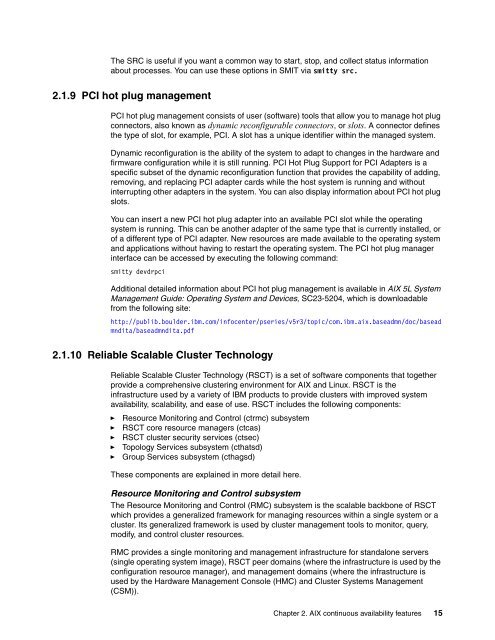IBM AIX Continuous Availability Features - IBM Redbooks
IBM AIX Continuous Availability Features - IBM Redbooks
IBM AIX Continuous Availability Features - IBM Redbooks
Create successful ePaper yourself
Turn your PDF publications into a flip-book with our unique Google optimized e-Paper software.
The SRC is useful if you want a common way to start, stop, and collect status information<br />
about processes. You can use these options in SMIT via smitty src.<br />
2.1.9 PCI hot plug management<br />
PCI hot plug management consists of user (software) tools that allow you to manage hot plug<br />
connectors, also known as dynamic reconfigurable connectors, or slots. A connector defines<br />
the type of slot, for example, PCI. A slot has a unique identifier within the managed system.<br />
Dynamic reconfiguration is the ability of the system to adapt to changes in the hardware and<br />
firmware configuration while it is still running. PCI Hot Plug Support for PCI Adapters is a<br />
specific subset of the dynamic reconfiguration function that provides the capability of adding,<br />
removing, and replacing PCI adapter cards while the host system is running and without<br />
interrupting other adapters in the system. You can also display information about PCI hot plug<br />
slots.<br />
You can insert a new PCI hot plug adapter into an available PCI slot while the operating<br />
system is running. This can be another adapter of the same type that is currently installed, or<br />
of a different type of PCI adapter. New resources are made available to the operating system<br />
and applications without having to restart the operating system. The PCI hot plug manager<br />
interface can be accessed by executing the following command:<br />
smitty devdrpci<br />
Additional detailed information about PCI hot plug management is available in <strong>AIX</strong> 5L System<br />
Management Guide: Operating System and Devices, SC23-5204, which is downloadable<br />
from the following site:<br />
http://publib.boulder.ibm.com/infocenter/pseries/v5r3/topic/com.ibm.aix.baseadmn/doc/basead<br />
mndita/baseadmndita.pdf<br />
2.1.10 Reliable Scalable Cluster Technology<br />
Reliable Scalable Cluster Technology (RSCT) is a set of software components that together<br />
provide a comprehensive clustering environment for <strong>AIX</strong> and Linux. RSCT is the<br />
infrastructure used by a variety of <strong>IBM</strong> products to provide clusters with improved system<br />
availability, scalability, and ease of use. RSCT includes the following components:<br />
► Resource Monitoring and Control (ctrmc) subsystem<br />
► RSCT core resource managers (ctcas)<br />
► RSCT cluster security services (ctsec)<br />
► Topology Services subsystem (cthatsd)<br />
► Group Services subsystem (cthagsd)<br />
These components are explained in more detail here.<br />
Resource Monitoring and Control subsystem<br />
The Resource Monitoring and Control (RMC) subsystem is the scalable backbone of RSCT<br />
which provides a generalized framework for managing resources within a single system or a<br />
cluster. Its generalized framework is used by cluster management tools to monitor, query,<br />
modify, and control cluster resources.<br />
RMC provides a single monitoring and management infrastructure for standalone servers<br />
(single operating system image), RSCT peer domains (where the infrastructure is used by the<br />
configuration resource manager), and management domains (where the infrastructure is<br />
used by the Hardware Management Console (HMC) and Cluster Systems Management<br />
(CSM)).<br />
Chapter 2. <strong>AIX</strong> continuous availability features 15

















